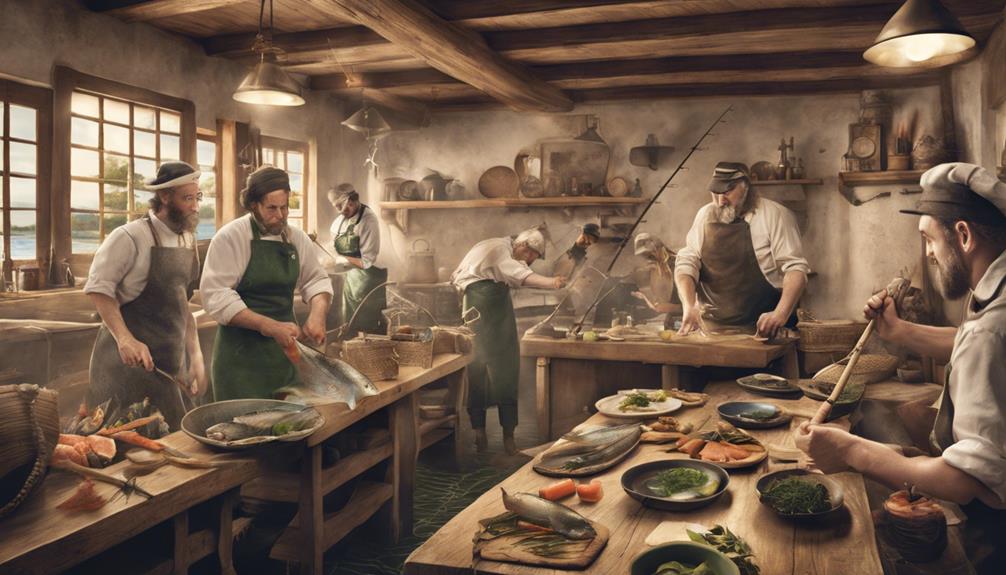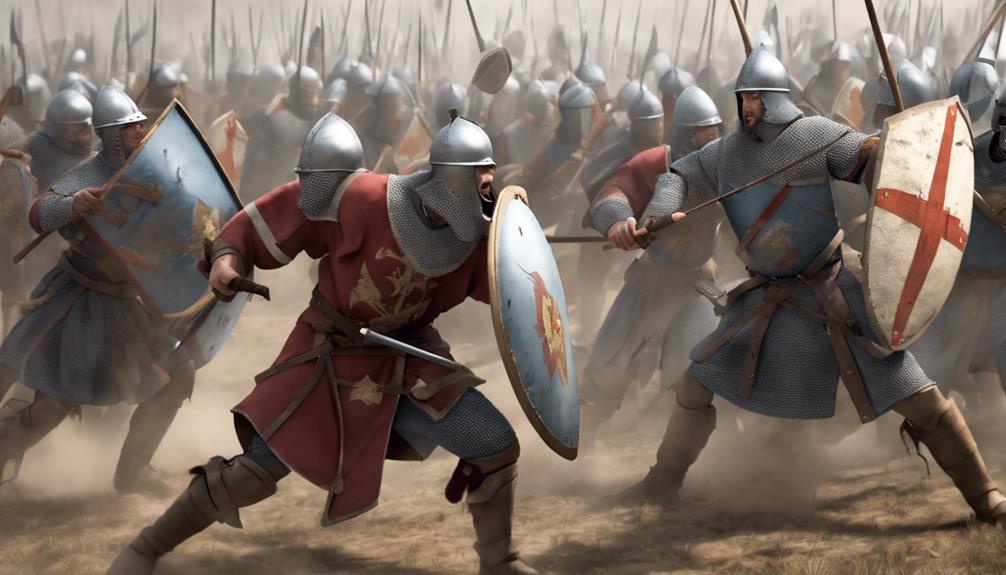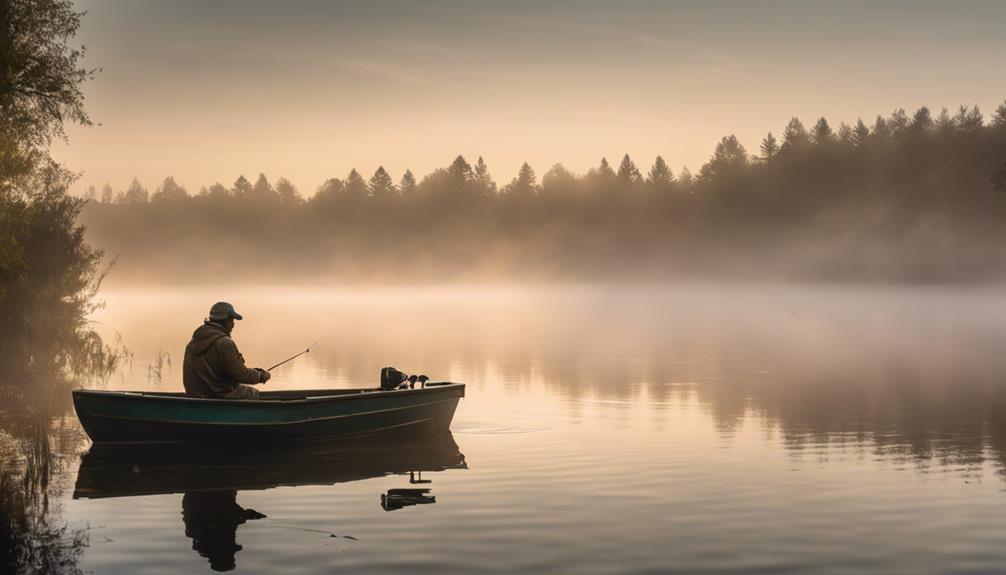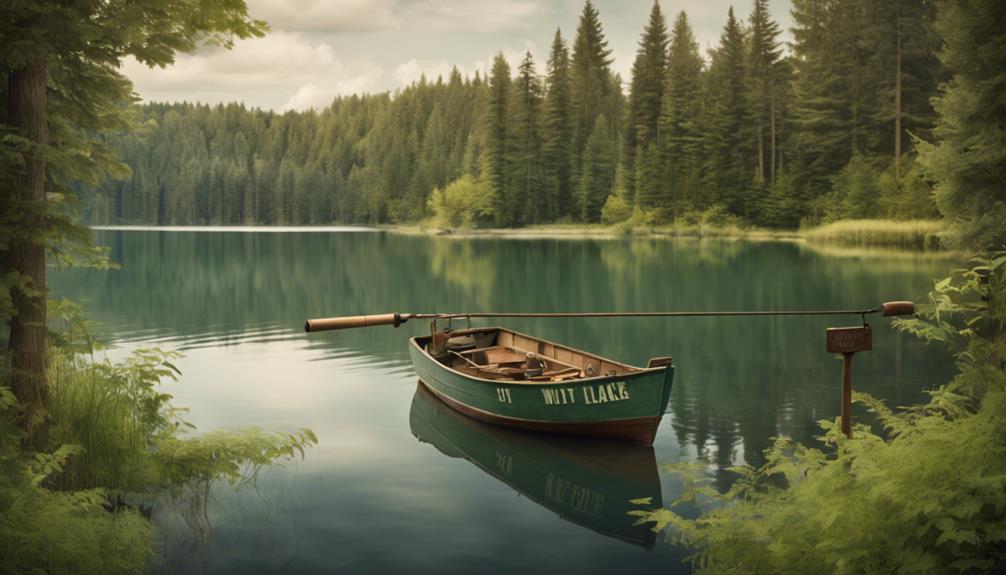Explore how angling shapes historic cuisine through freshness emphasis, grilling, smoking, and curing techniques. Anglers sourcing ingredients directly from nature enhance natural fish flavors with carefully curated herbs and spices. Regional traditions reflect angling practices, with indigenous ingredients defining culinary identities. Anglers inspire culinary innovation by creating fusion cuisine, new flavor combinations, and innovative cooking techniques. The impact of angling on historic cuisine is profound, transcending mere sustenance to weave a tapestry of flavors and cooking methods, enriching the culinary world. Discover the intricate connection between angling and historic cuisine for a deeper understanding of culinary evolution.
Evolution of Cooking Techniques
Through centuries of innovation and experimentation, anglers have significantly influenced the evolution of cooking techniques, revolutionizing how dishes are prepared and served. One of the key ways in which anglers have impacted cooking methods is through their emphasis on freshness. By catching fish directly from rivers, lakes, or oceans, anglers ensure that the fish is of the highest quality. This focus on freshness led to the development of cooking techniques that highlight the natural flavors of the fish, such as grilling or searing, which help to preserve the delicate flavor profiles of the catch.
Furthermore, anglers played a crucial role in the development of smoking and curing techniques. Historically, these methods were essential for preserving fish before the advent of refrigeration. Anglers would smoke or cure their catch to extend its shelf life, resulting in unique flavor profiles that are still enjoyed today. The smoking process not only preserved the fish but also imparted a rich, smoky flavor that enhanced the overall taste of the dish.
Additionally, anglers were pioneers in the art of marinating fish. By soaking the fish in a mixture of herbs, spices, and oils, anglers were able to infuse the fish with complex flavor profiles, creating dishes that were both flavorful and aromatic. These marinating techniques have since been adopted and adapted by chefs around the world, showcasing the lasting impact of anglers on cooking methods and flavor profiles.
Influence on Ingredient Selection
Anglers' deep connection to the natural environment profoundly influences their meticulous selection of ingredients for culinary creations. The act of sourcing ingredients directly from nature, whether it's freshly caught fish or foraged herbs, allows anglers to bring a unique and authentic touch to their dishes. This emphasis on ingredient sourcing not only ensures the freshness and quality of the components but also adds a layer of sustainability and respect for the environment.
When it comes to flavor profiles, anglers' ingredient selection is driven by a desire to enhance the natural taste of the fish they catch. For example, the choice of herbs, spices, and other accompaniments is carefully curated to complement the delicate flavors of the fish without overpowering them. Anglers understand the nuances of different species of fish and how to pair them with ingredients that will elevate their taste.
Moreover, the process of selecting ingredients is often intertwined with the fishing experience itself. Anglers may gather herbs and other ingredients from the surroundings where they fish, creating a seamless connection between the environment, the fishing activity, and the culinary outcome. This holistic approach to ingredient selection not only results in delicious dishes but also reflects a deep appreciation for nature and the role it plays in shaping culinary traditions.
Regional Culinary Traditions
Within the realm of culinary exploration, the diverse regional traditions deeply influenced by angling practices offer a rich tapestry of flavors and techniques. Regional culinary traditions often reflect the indigenous ingredients available in a specific area, showcasing the connection between angling and local culinary identities. In coastal regions, for example, seafood caught through angling forms the cornerstone of many traditional dishes, such as clam chowder in New England or ceviche in Latin America. These dishes not only highlight the freshness of the catch but also celebrate the cultural importance of angling in these communities.
Moreover, regional culinary traditions exhibit cultural adaptations that have been shaped by angling practices over generations. In areas where fishing is a way of life, such as Scandinavia, techniques like smoking fish have been refined and passed down through families, resulting in delicacies like Swedish gravlax. Similarly, in Japan, the art of sushi-making is intricately tied to the fishing industry, with each region boasting its own unique sushi styles based on the local catch.
Impact on Culinary Innovation
The influence of angling on regional culinary traditions hasn't only preserved historical recipes but also sparked culinary innovation in unexpected ways. Anglers bring not only the catch of the day but also a spirit of culinary creativity to the kitchen. This infusion of fresh ideas and ingredients has led to flavor experimentation that has revolutionized traditional dishes and created new culinary delights.
- Fusion Cuisine: Anglers often bring back a diverse catch, inspiring chefs to blend different culinary traditions and ingredients to create unique fusion dishes.
- Ingredient Pairing: The variety of fish caught through angling has encouraged chefs to experiment with new flavor combinations, leading to the discovery of exciting ingredient pairings.
- Technique Innovation: Anglers' fresh catches have pushed chefs to develop new cooking techniques to make the most of the flavors and textures of the fish, leading to innovative cooking methods.
- Menu Diversification: The availability of a wide range of fish species through angling has allowed restaurants to diversify their menus, offering customers a broader selection of seafood dishes to enjoy.
The impact of angling on culinary innovation showcases how a traditional activity can inspire creativity in the kitchen, pushing chefs to think outside the box and create dishes that tantalize taste buds and celebrate the diversity of flavors that the world of angling has to offer.
Frequently Asked Questions
How Did Angling Impact the Development of Food Preservation Methods?
When angling, you influenced food preservation methods. Salt preservation was key, as it helped preserve fish by drawing out moisture and inhibiting bacterial growth.
Drying techniques also played a crucial role, allowing fish to be preserved for longer periods. Additionally, fermentation methods were employed, such as pickling, which involved submerging fish in brine to create a tangy flavor and extend shelf life.
Angling thus impacted food preservation through a variety of techniques.
Were There Any Superstitions or Rituals Associated With Angling in Historic Cuisine?
When it comes to angling in historic cuisine, superstitions and rituals played a significant role. Many believed that certain rituals before fishing could bring about a bountiful catch. Folklore often included tales of specific behaviors or offerings that appeased the water spirits and ensured a successful fishing trip.
These beliefs were deeply ingrained in the angling culture of the past and added a mystical element to the practice of fishing for sustenance.
Did Angling Have Any Influence on the Use of Herbs and Spices in Cooking?
When you think about angling's impact on herb and spice usage in cooking, it becomes evident how anglers would bring back fresh catches and accentuate them with herbs and spices. This practice led to the development of flavorful dishes through herbal infusion and the creation of unique flavor profiles that enhanced the natural taste of the fish.
Angling not only provided food but also inspired culinary experimentation with different seasonings.
Were There Any Specific Social Classes or Groups Associated With Angling Practices?
When it comes to fishing traditions, various social classes have been associated with angling practices throughout history. Wealthier individuals often engaged in angling as a leisurely pursuit, enjoying the sport and the relaxation it provided.
In contrast, those from lower socioeconomic backgrounds might've relied on fishing as a means of sustenance, showcasing the diverse roles that fishing played in different societal groups. These distinctions in social classes highlight the multifaceted nature of angling traditions.
How Did Angling Affect the Development of Cooking Utensils and Tools?
When you think about angling's impact on cooking utensils and tools, you'll see how it spurred innovative technologies and culinary techniques.
Anglers needed efficient ways to prepare their catches, leading to the development of specialized knives, gutting tools, and cooking implements. This necessity pushed for advancements in material science and craftsmanship, laying the foundation for modern kitchen equipment.
The marriage of angling and culinary arts birthed a wave of practical and sophisticated tools we still use today.
Conclusion
By examining the ways in which angling has shaped historic cuisine, it becomes clear that this age-old practice has had a profound impact on the evolution of cooking techniques, ingredient selection, regional culinary traditions, and culinary innovation.
From ancient civilizations to modern societies, angling has played a significant role in shaping the way we prepare and enjoy food. Its influence continues to be felt in kitchens around the world, connecting us to our culinary heritage in a truly unique way.



